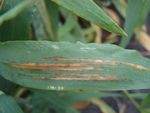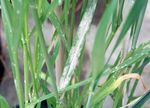Barley Pest Initiative Targets
←
→
Page content transcription
If your browser does not render page correctly, please read the page content below
Barley Pest Initiative Targets
The Barley Pest Initiative (BPI) strengthens research capacity to address over twenty major insect,
viral, bacterial, and fungal threats to the production of high-quality barley, which improves returns
to growers and meets the needs of domestic and export end-users. It is directed to develop
management and genetic resistance strategies to mitigate or eliminate the economic impact of
these major barley pests, keeping barley a viable option for U.S. growers, and enhancing value-added
job generating enterprises in the U.S. The BPI is a multi-disciplinary and multi-institutional
collaborative research project of Agricultural Research Service (ARS) intramural (~80%) and
extramural university (~20%) programs, involving scientists in fourteen states.
VIRAL DISEASES
PROBLEM: substantial yield and quality reductions from stunting, rosetting, foliar
symptoms (yellowing, mottling, streaking), and can interfere with nutrient
transport
RESEARCH: develop control methods for aphids (disease vectors) to promote safe
and environmentally sound practices, develop new barley varieties with diverse
sources of resistance
CEREAL YELLOW DWARF VIRUSES (CYDV)
With many genetically different variants, complicating development of resistance,
CYDV is the most economically significant viral disease threat to barley. Infected
plants display yellow discoloration, are dwarfed in height, leaves may be
shortened or curled, and in severe infections, fewer tillers may develop and heads
may not emerge. Infected plants are more vulnerable to fungal diseases and
drought stress. Losses from CYDVs can approach 100% with early infections.
Winter barley is more at risk than spring barley since aphid populations often
build up during the growing season, migrate to and increase the incidence of
infection in fall planted barley crops, that provide a “green-bridge” into the next
growing season.
BACTERIAL DISEASES
PROBLEM: produces reductions in yield and quality
RESEARCH: greater understanding of the biology of the bacterium and its
virulence mechanisms to develop resistant varieties
BACTERIAL LEAF STREAK (BLS)
As the only major bacterial disease in barley, BLS also does not have an existing
fungicide control. Small, water-soaked lesions elongate into linear streaks, with a
characteristic milky exudates on the leaf surface. Little is known about the disease
system. The bacteria are believed to mainly survive on seeds, and using clean
seeds may reduce disease incidence and decrease disease epidemics.
1FUNGAL DISEASES
PROBLEM: most prevalent threat to barley production through yield and quality
reductions, worsened by growing resistance to existing fungicide options
RESEARCH: develop control methods to promote safe and environmentally sound
practices, develop new barley varieties with diverse sources of resistance
RUSTS - brown to reddish-brown or yellow pustules erupt through the plant tissue,
with the rusty spores giving rust diseases their name
Stem rust: primarily affects barley stems and leaf sheaths, but leaf blades and
heads may also be infected. Infected plants produce shriveled kernels, and
weakened stems result in severe lodging, with fallen plants further reducing yield
and quality. Existing resistance in modern varieties has weakened over time. A
serious threat to barley production worldwide is African stem rust, which more
than 95% of the world’s barley cultivars are susceptible to, and it is expected to
eventually spread to the U.S.
Leaf rust: most prevalent in areas where the crop matures late, most extensively
in the Eastern and Midwestern U.S. Losses can be severe, especially when plants
are infected early in the season and when infections occur on the flag leaf,
significantly reducing grain yield. Infected plants have smaller leaves, weaker
stems, earlier maturity, and lower yield and quality. Leaf rust appeared for the
first time inland in the Pacific Northwest in 2017 and caused complete yield losses
in several barley fields. The majority of commercial barley varieties are
susceptible.
Stripe rust: also known as yellow rust, is primarily a disease of cool climates, thus
its main impact is on barley grown at high elevations in Western states or on
winter barley. Symptoms usually appear earlier in year than leaf or stem rust, with
yellow pustules often arranged in stripes occurring on leaves and occasionally in
heads.
BLOTCHES
Spot blotch: occurs wherever barley is grown, causing the most significant yield
losses in warm, humid areas. Spots develop on leaves and leaf sheaths at all stages
of plant development, with the greatest losses occurring when infection impacts
the flag leaf. Because it can be seedborne, the use of pathogen-free seed or
fungicide seed treatments are used in control, along with foliar fungicide
applications.
Net blotch: named for net-like symptoms on barley leaves and leaf sheaths, the
causal fungal species is divided into two forms; one causing net form net blotch,
and the more recently described form causing spot form net blotch. Both forms
are common wherever barley is grown, especially in areas of high humidity and
rainfall. Yield losses can approach 100% in severely infected fields of susceptible
varieties. Destruction of host debris, rotation with non-susceptible crops and use
of pathogen-free seed are management tools.
Septoria speckled leaf blotch: cool, wet climates, such as the Upper Midwest, can
experience widespread production losses. The pathogen primarily attacks the
leaves and leaf sheaths, causing lesions that become densely populated with dark
fruiting bodies that release spores, which give the disease its name. The disease
reduces yield and malting quality, including reduced malt extract. Destroying
barley debris with deep plowing or rotating barley with non-susceptible crops
reduces disease severity, but contradicts trends in no-till management.
2FUNGAL DISEASES continued...
SMUTS - less prevalent with improved fungicidal seed controls
Covered smut: widespread, causing economic damage when untreated seed is planted.
Smut spores contaminate clean grain at harvest when smutted heads are broken and
crushed during threshing. The released spores collect on the surface and in the crevices of
the grain, and are also deposited in the soil where the spores may survive on seed or in
soil. The fungus infects the growing seedling, becomes established in the growing point,
and at the time of flower formation, it creates a fungal mass encased by a membrane
which forms a small bunt ball in place of the seed.
Loose smut: more common in areas of high humidity and rainfall, yield losses and quality
impacts are usually less than with covered smut, since harvested grain appears clean.
Infection occurs when spores infect healthy barley heads at flowering. Those infected
seeds are internally colonized and when planted, the fungus grows up with the plant. The
infected heads grow faster and emerge earlier than normal, and their spikelets are
entirely transformed into a loose spore mass, which shed their spores into the wind.
Within a few days, only the head’s stem remains, thus the name loose smut. The spores
land on healthy barley heads, then infect the next generation of seeds. The fungus
survives from one growing season to the next dormant within the embryo of the seed, so
surface fungicide seed treatments are not effective. Specific systemic fungicides or hot or
cold water treatments are used to reduce infections within the seed.
SOIL-BORNE FUNGAL PATHOGENS ATTACKING ROOTS & SEEDS
Several soil-borne fungi cause substantial yield losses and are consistently problematic when
crop rotation is limited. Many of these disease-causing fungi take advantage of conditions
that are not favorable to the plants (cold wet spring soils, water-logged soils, or droughty
water-stressed conditions). Fungicide resistance has been documented in Pythium, a fungus-
like organism that causes damping-off, resulting in poor root growth and seedling vigor when
seeds are planted in early spring. Rhizoctonia fungi infect many different crops, and are very
damaging in barley where we have “green-bridge” conditions. Those diseases and Fusarium
crown rot, strawbreaker foot rot, and sharp eyespot do well in no-till conditions that favor soil
and moisture conservation, severely limiting the economic viability of practices that improve
soil health. Except for seed treatment, there are no chemical controls for these disease and
limited resistance exists.
POWDERY MILDEW
Infecting the epidermal surface cell layer, PM completes its life cycle in just 5-7 days, with the
fungi and its spores covering the leaves, stems, and heads with a powdery appearance. It
damages the plant by reducing photosynthesis and increasing transpiration and respiration,
reducing yield and quality. Powdery mildew can survive the winter on barley and is increasing
in prevalence and economic impact as winter barley acreage increases. Spores can also jump
to spring barley, continuing the cycle of infection. Although fungicide controls exist, genetic
resistance is a preferred management strategy.
SCALD
As a common disease of barley, especially in cooler, semi-humid areas, scald is recognized by
distinctive lesions formed on leaves and other plant parts. Yield losses occur through reduced
kernel weight, and in severe infections, the number of kernels per head and number of heads
per plant may be reduced. Scald can be controlled with fungicides, but the best approach is
the reduction of the stubble and residue harboring the fungi, sowing clean or certified seed
harvested from an uninfected crop, and the development of resistant barley varieties.
3INSECTS
PROBLEM: reduce yield and quality through feeding, potential to inject toxins or
transmit disease
RESEARCH: develop control methods to promote safe and environmentally sound
practices, develop new barley varieties with diverse sources of resistance
APHIDS
Russian wheat aphid (RWA): Causes reduced fertility and thin seeds as a result of
head trapping. Aphids build up in high numbers inside new unrolled leaves where
they are protected from contact insecticides, other natural parasites and
predators, wind and rain.
Greenbug (GB): Pest of winter barley in Southern Plains
Bird cherry-oat aphid (BCOA): Can vector yield-devastating viruses and has been
reported to cause yield reductions of up to 50% from aphid feeding alone.
Hedgehog grain aphid (HGA): Reported to feed on more than 52 different species
of grasses and cereal crops with wheat and barley as preferred hosts. Feeding
results in yellowing and withering of leaves leading to reduced yield and grain
quality.
WHEAT STEM SAWFLY
Females deposit eggs in the upper part of the stem, with the larvae tunneling through
the stem as it feeds, reducing yield and grain quality. Weakened stems result in
lodging (stem collapse), further reducing quality and harvestable yield. Sawfly is
difficult to control with insecticides, as larvae are protected from treatment and the
adults do not feed as they rapidly migrate over wide areas to other fields.
HAANCHEN BARLEY MEALYBUG
Causes tremendous yield loss of barley and wheat in dryland production areas of the
Intermountain West. The mealy bugs feed at the base of the stems under the soil
surface, severely reducing root growth while injecting damaging toxins into the plant
stems, eventually killing the plant. Insecticides cannot reach the protected larvae;
thus, the control recommendations include tillage in areas where minimum tillage is
favored for soil and water conservation.
NEMATODES
Various species feed on barley roots in areas of limited crop rotation (cereal cyst
nematode-CCN) or even under the best crop rotation practices (lesion nematodes,
stunt nematodes, etc.). Yield damage under irrigation from high populations of CCN
has been as high as 50%.
WIREWORMS
Many crops are damaged by soil borne wireworms, which are the larval stage of the
click beetle. The insects can kill entire patches of seedling barley within a field,
reducing yield and allowing weeds to become established. There are over twelve
species of wireworm damaging cereals, each with different patterns of behavior
influencing or changing control tactics. Available insecticidal seed treatments are not
completely effective, and new control strategies need to be developed and
implemented to reduce damage.
4You can also read
























































